Birding South Texas with Golden Gate Bird Alliance
By Steve and Carol Lombardi
In April, we joined five other Golden Gate Bird Alliance members on a nine-day birding adventure to the South Texas coast and the lower Rio Grande Valley. Eddie Bartley and Noreen Weeden of NatureTrip, both longtime GGBA members, were our excellent, well-organized guides.
The South Texas coast is a top birding destination in the spring because of the migrant “fall-out” – tens of thousands of birds descending for rest and food after their long flight north over the waters of the Gulf of Mexico.
Highlights of the trip included
- 222 species on our list. Lots of warblers and other neotropical migrants, helped in part by the migrant fall-out at South Padre Island: One of those “Over here! Over there! And over there!” mornings.
- Thirty different spots visited, including state parks, roadside rests, beach towns, and wildlife refuges. We traversed the southeast corner of the state, starting in Corpus Christie, going south to the South Padre Island/Brownsville area, up the Rio Grande Valley as far as McAllen, and back to Corpus.
- Nine days of good accommodations, including five very nice 3-star hotels and a bunch of very, very good meals—yes, even vegetarian!
- Good weather (for the humans). The area can be uncomfortably hot this time of year. Instead, we had cold fronts, which kept the daytime weather temperate and cloudy and contributed to the fall-outs we witnessed.
The gulf coast is definitely a tourist destination, as is apparent from the architecture. But they also take their birding seriously. Local conservation groups have purchased woodlots and marshes in the middle of neighborhoods to protect them from development and provide habitat. Result: Great birding with on-street parking.
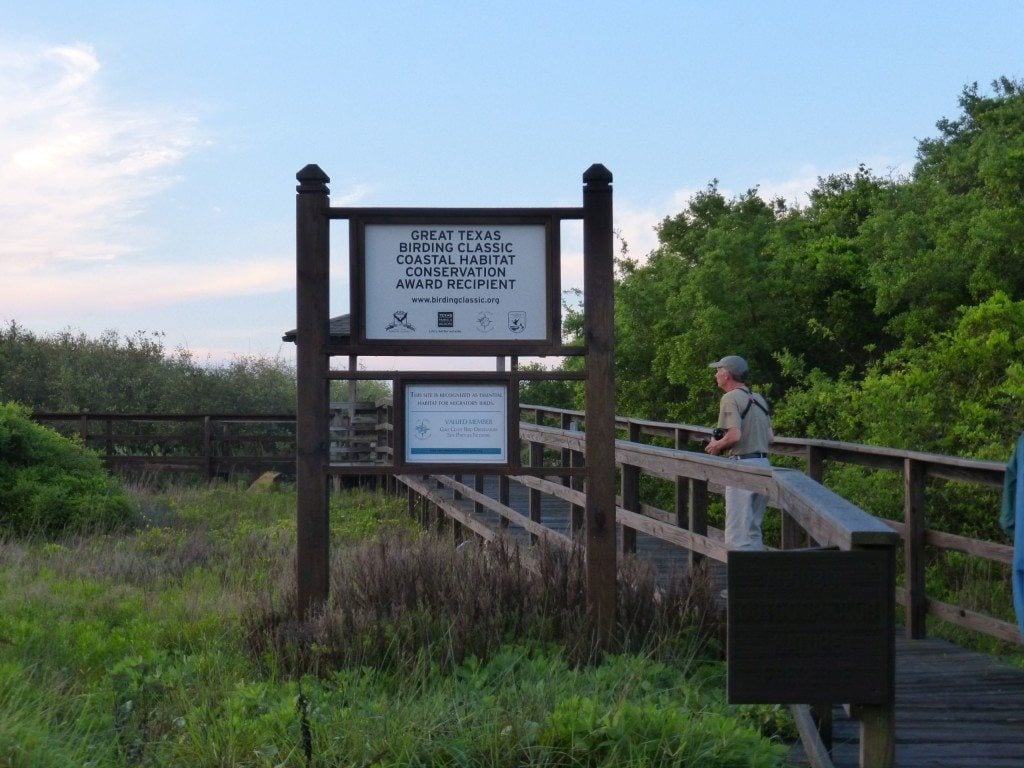
within the residential area—also wins the Most Adjectives In A Plaque Award.
We spent our first day of the trip in and around Port Aransas, across the bay from Corpus Christie on Mustang Island. We were treated to great close-up views of migrating shorebirds on the beaches and neotropical migrants in the nearby woodlots. As Californians, we were pretty well bundled up against the expected bugs. So we were bemused (well, shocked, really) to see many of the local folks out birding in shorts, t-shirts, and flip-flops. We hit half a dozen well-known spots in this area and—among other lessons—grasped the difference between Laughing and Franklin’s Gulls.
After a rain delay that forced us to kill some time in a German bakery (oh, woe is us), we headed south toward Brownsville and South Padre Island, where we spent three nights.
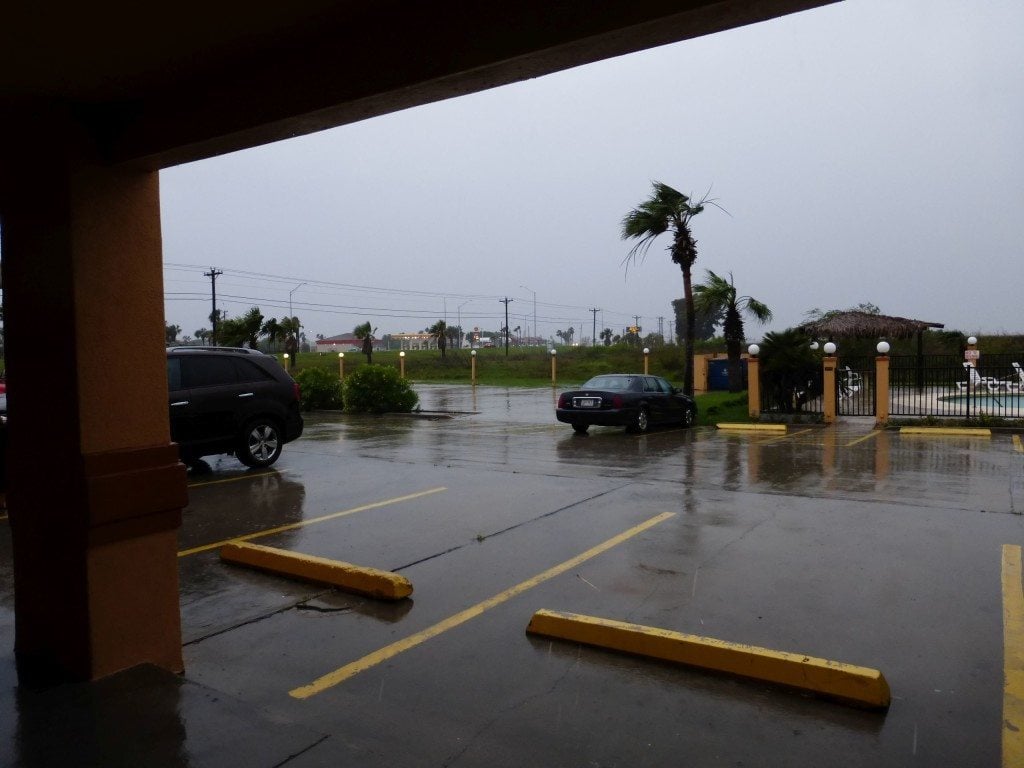
There’s an old joke about a thin man: The guy is so skinny that if he turned sideways and stuck out his tongue, he’d look like a zipper. That’s South Padre Island (“SPI” to the locals). The back of our hotel, the Hilton Garden Inn, is on the gulf coast. Walk across the street, and you’re on the opposite side of the island.
Which we did. We found fabulous birding in bird-friendly landscaping right across the street from our hotel, at both the convention center and the South Padre Island Birding and Nature Center. Besides having woodlots where the migrants were falling out, both places have boardwalks through a marsh, where we got great looks at Clapper Rails, Yellow-Crowned Night-Herons, and Least Bitterns (one of our target birds, finally seen after a laborious search), and a good-sized ‘gator. We visited several other spots in the area, but returned repeatedly to these two spots because of the excellent birding. Dozens of other birders were there as well…a friendly and knowledgeable bunch.
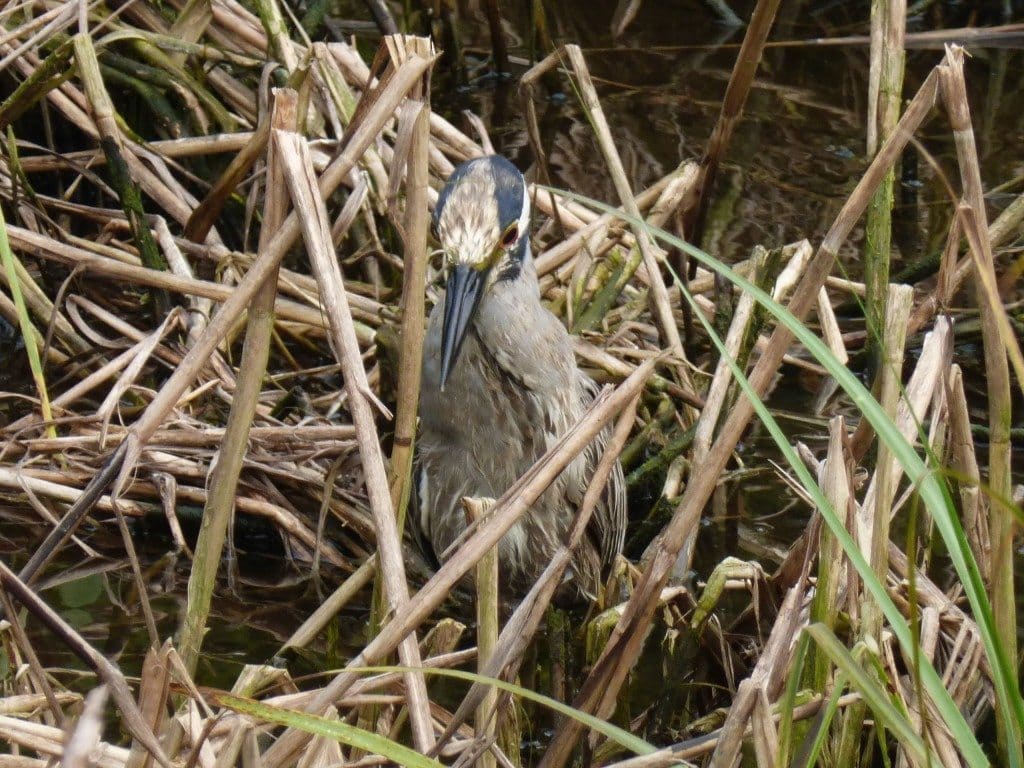
SPI becomes a congested, touristy mess on weekends, so Eddie and Noreen wisely scheduled our trip so that we were pulling out Friday morning just as a motorcycle convention was pulling in to take over the convention center.
Friday was our first of two nights spent in another nice Hilton Garden Inn, this one in McAllen, in the middle of the lower Rio Grande Valley. We spent the next two days exploring the state parks and refuges there.
We were pleasantly surprised at the great condition of the state parks, roadside rests, and other state facilities. We found them to be well built, well maintained, and well staffed. And they even spent a little money on aesthetics, as in this restroom mosaic at a rest area.
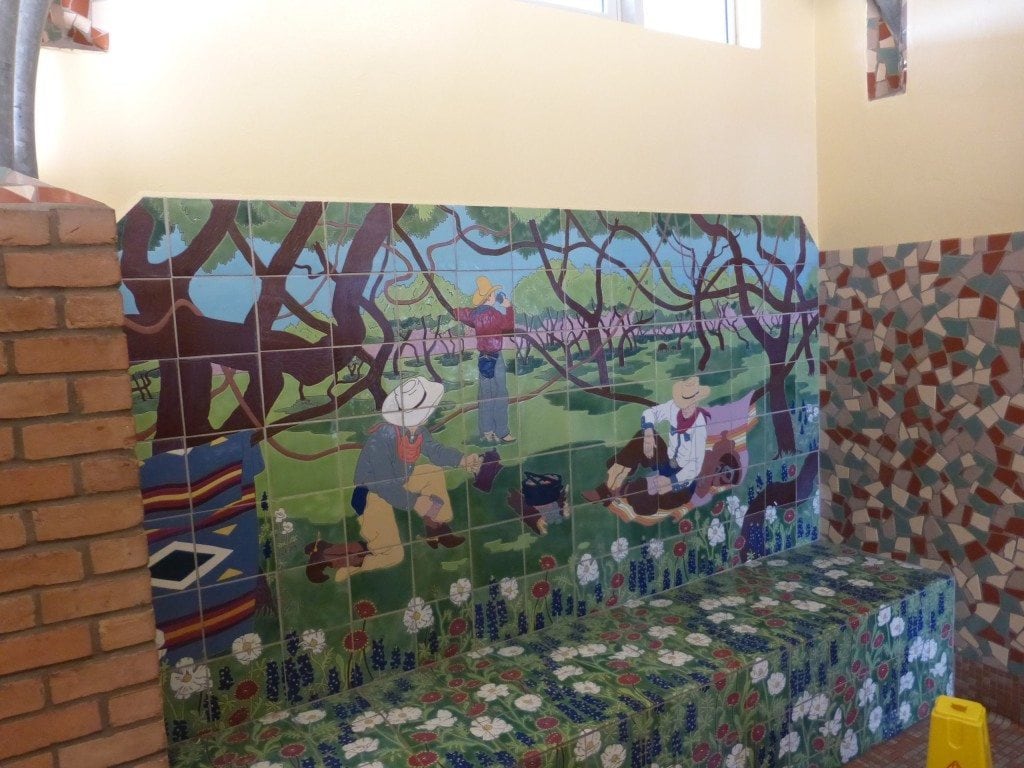

We saw some great birds in the valley, high in the air, low on the ground, and in between.
From a hawkwatch tower at Bentsen-Rio Grande Valley State Park, we watched a kettle of 60 or so Broad-winged Hawks. On the ground nearby, we found a Common Paraque parent sheltering a chick under each wing. In between, Northern Beardless-Tyrannulet and Clay-colored Thrush, two of our target species, rewarded our stalwart guides’ persistence.
Even the city birding was interesting. After dinner in Weslaco, we watched at least 150 Red-crowned Parrots gather on the Walgreen lot’s utility wires. Click here to listen to an audio file of their chattering.
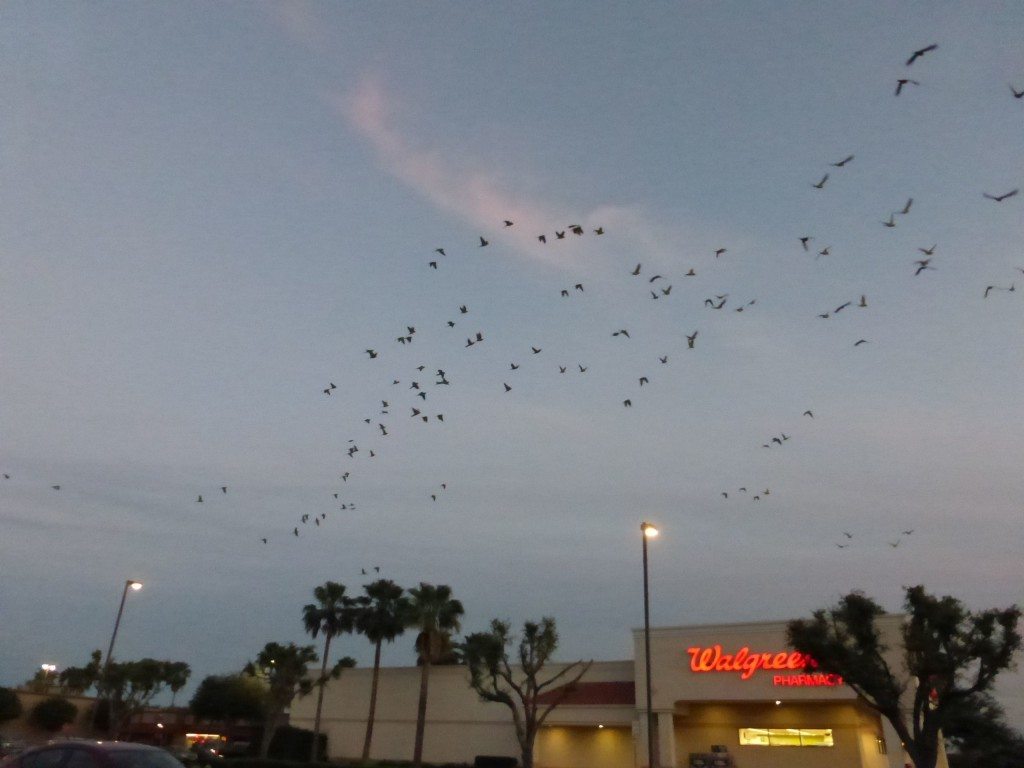
On our last full day of birding before heading back to Corpus Christie, we spent the day at the iconic, enormous, fabulous King Ranch. (Yes, really. You should Google it). The birding was a little slow. But in our last half hour, we finally saw two of our targets, Tropical Parula and Ferruginous Pygmy-Owl. In spite of the relatively slow birding, the place is amazing and was well worth spending the day. The habitat and landscape are beautiful, and we were constantly being surprised by critters, both native and exotics, like an impala hanging around one of the farm residences.
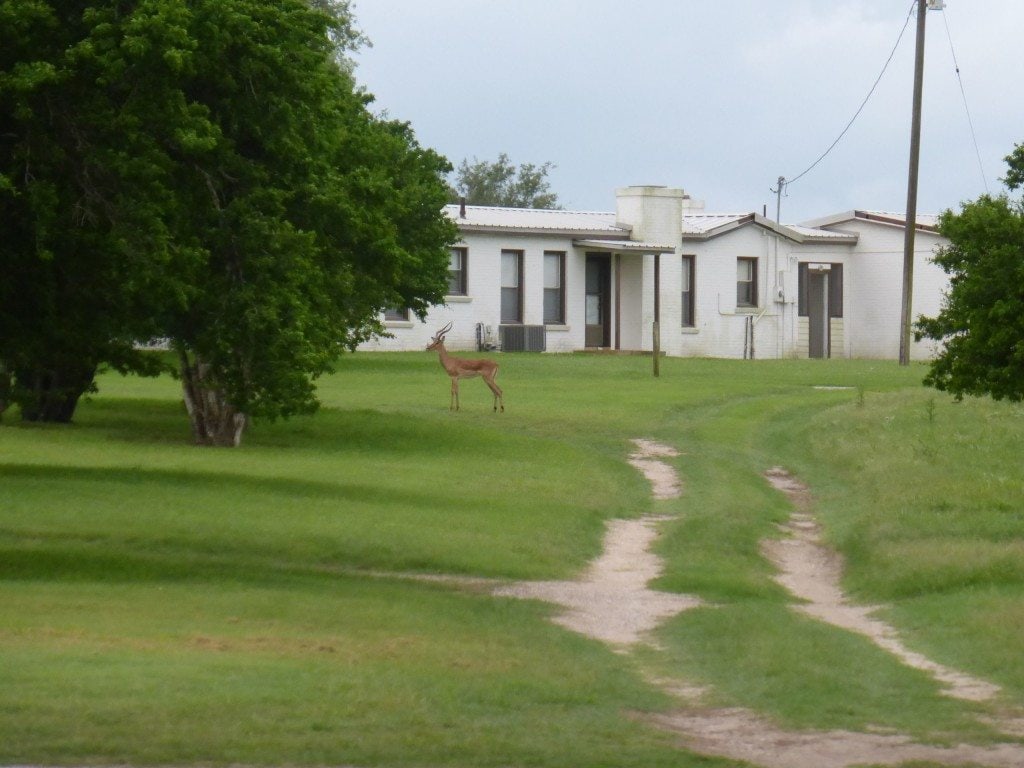
Great trip with great people. Highly recommended. We’re happy to answer any questions if you’d like to contact us at hotrock175@gmail.com. For a list of the species we identified, see South Texas 2015 Checklist.
———————————————
Golden Gate Bird Alliance will sponsor a South Texas trip again next year, from April 10-19, 2016. For information on that trip and our full roster of other international and domestic birding tours in 2016, see the Travel with GGBA page of our web site. Or contact Eddie Bartley for information at eddie@naturetrip.com.
